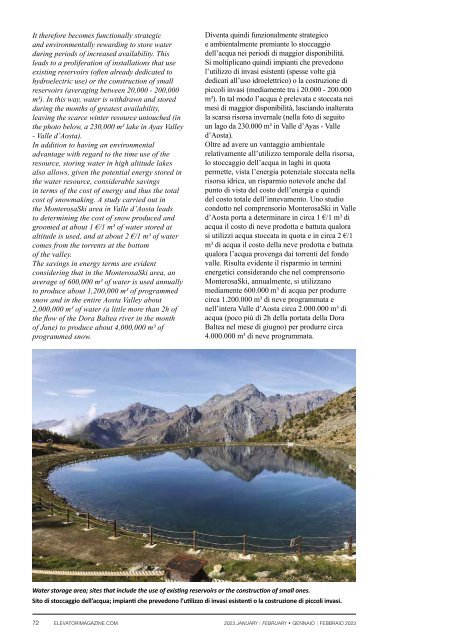Elevatori Magazine 1 - 2023
January - February
January - February
- TAGS
- elevatori magazine
You also want an ePaper? Increase the reach of your titles
YUMPU automatically turns print PDFs into web optimized ePapers that Google loves.
It therefore becomes functionally strategic<br />
and environmentally rewarding to store water<br />
during periods of increased availability. This<br />
leads to a proliferation of installations that use<br />
existing reservoirs (often already dedicated to<br />
hydroelectric use) or the construction of small<br />
reservoirs (averaging between 20,000 - 200,000<br />
m3). In this way, water is withdrawn and stored<br />
during the months of greatest availability,<br />
leaving the scarce winter resource untouched (in<br />
the photo below, a 230,000 m3 lake in Ayas Valley<br />
- Valle dʼAosta).<br />
In addition to having an environmental<br />
advantage with regard to the time use of the<br />
resource, storing water in high altitude lakes<br />
also allows, given the potential energy stored in<br />
the water resource, considerable savings<br />
in terms of the cost of energy and thus the total<br />
cost of snowmaking. A study carried out in<br />
the MonterosaSki area in Valle dʼAosta leads<br />
to determining the cost of snow produced and<br />
groomed at about 1 €/1 m3 of water stored at<br />
altitude is used, and at about 2 €/1 m3 of water<br />
comes from the torrents at the bottom<br />
of the valley.<br />
The savings in energy terms are evident<br />
considering that in the MonterosaSki area, an<br />
average of 600,000 m3 of water is used annually<br />
to produce about 1,200,000 m3 of programmed<br />
snow and in the entire Aosta Valley about<br />
2,000,000 m3 of water (a little more than 2h of<br />
the flow of the Dora Baltea river in the month<br />
of June) to produce about 4,000,000 m3 of<br />
programmed snow.<br />
Diventa quindi funzionalmente strategico<br />
e ambientalmente premiante lo stoccaggio<br />
dell’acqua nei periodi di maggior disponibilità.<br />
Si moltiplicano quindi impianti che prevedono<br />
l’utilizzo di invasi esistenti (spesse volte già<br />
dedicati all’uso idroelettrico) o la costruzione di<br />
piccoli invasi (mediamente tra i 20.000 - 200.000<br />
m3). In tal modo l’acqua è prelevata e stoccata nei<br />
mesi di maggior disponibilità, lasciando inalterata<br />
la scarsa risorsa invernale (nella foto di seguito<br />
un lago da 230.000 m3 in Valle d’Ayas - Valle<br />
d’Aosta).<br />
Oltre ad avere un vantaggio ambientale<br />
relativamente all’utilizzo temporale della risorsa,<br />
lo stoccaggio dell’acqua in laghi in quota<br />
permette, vista l’energia potenziale stoccata nella<br />
risorsa idrica, un risparmio notevole anche dal<br />
punto di vista del costo dell’energia e quindi<br />
del costo totale dell’innevamento. Uno studio<br />
condotto nel comprensorio MonterosaSki in Valle<br />
d’Aosta porta a determinare in circa 1 €/1 m3 di<br />
acqua il costo di neve prodotta e battuta qualora<br />
si utilizzi acqua stoccata in quota e in circa 2 €/1<br />
m3 di acqua il costo della neve prodotta e battuta<br />
qualora l’acqua provenga dai torrenti del fondo<br />
valle. Risulta evidente il risparmio in termini<br />
energetici considerando che nel comprensorio<br />
MonterosaSki, annualmente, si utilizzano<br />
mediamente 600.000 m3 di acqua per produrre<br />
circa 1.200.000 m3 di neve programmata e<br />
nell’intera Valle d’Aosta circa 2.000.000 m3 di<br />
acqua (poco più di 2h della portata della Dora<br />
Baltea nel mese di giugno) per produrre circa<br />
4.000.000 m3 di neve programmata.<br />
Water storage area; sites that include the use of existing reservoirs or the construction of small ones.<br />
Sito di stoccaggio dell’acqua; impianti che prevedono l’utilizzo di invasi esistenti o la costruzione di piccoli invasi.<br />
72 ELEVATORIMAGAZINE.COM <strong>2023</strong> JANUARY | FEBRUARY • GENNAIO | FEBBRAIO <strong>2023</strong>













